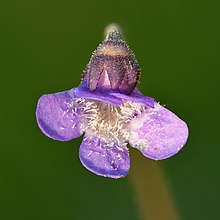|
Pinguicula vulgaris
Pinguicula vulgaris, the common butterwort, is a perennial carnivorous plant in the butterwort genus of the family Lentibulariaceae. DescriptionIt grows to a height of 3–16 centimetres (1.2–6.3 in), and is topped with a purple, and occasionally white, flower that is 15 millimetres (0.59 in) or longer, and shaped like a funnel. This butterwort grows in damp environments such as bogs and swamps, in low or subalpine elevations.[1] Being native to environments with cold winters, they produce a winter-resting bud (hibernaculum). There are three forms originating from Europe: P. vulgaris f. bicolor, which has petals that are white and purple; P. vulgaris f. albida, which has all white petals; and P. vulgaris f. alpicola, which has larger flowers.[2] The taxonomic status of these forms is not universally recognised – see e.g. The Plant List.[3] Common butterwort is an insectivorous plant. Its leaves have glands that excrete a sticky fluid that traps insects; the glands also produce enzymes that digest the insects.[4] This serves as a way for the plant to access a source of nitrogen, as they generally grow in soil that is acidic and low in nutrients, such as bogs.[4][5] Insect capture is an adaptation to nutrient-poor conditions, and the plant is highly dependent on insects for nitrogen.[6] DistributionIt has a generally circumboreal distribution, being native to almost every country in Europe as well as Russia, Canada, and the United States.[5][7] It is generally found growing in places such as bogs, fens, alvars, and other areas with limestone bedrock and alkaline waters.[5]
References
External links |
||||||||||||||||||||||||||||||||




![Anticosti Island, Mc Donald River[8] bank, Quebec, Canada](http://upload.wikimedia.org/wikipedia/commons/thumb/a/a9/Pinguicula_vulgaris_001.jpg/80px-Pinguicula_vulgaris_001.jpg)

![Anticosti Island, Mc Donald River[8] bank, Quebec, Canada](http://upload.wikimedia.org/wikipedia/commons/thumb/8/87/Pinguicula_vulgaris_002.jpg/120px-Pinguicula_vulgaris_002.jpg)